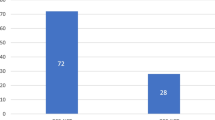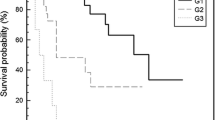Abstract
Neuroendocrine tumors originate from neuroendocrine cells and occur in a wide spectrum from carcinoid tumors to small cell carcinomas. Although the World Health Organization determined clinical and histological features to predict prognosis for such tumors, they may not be valid on an individual basis. This study investigates the clinical, pathologic and prognostic characteristics of gastroenteropancreatic neuroendocrine tumors that presented to the Medical Oncology Outpatient Clinic, İstanbul University, Cerrahpaşa School of Medicine from 1995 to 2006 (n = 86). The mean age of the patients was 52 ± 14 and the male-to-female ratio was 0.87. The most common site of involvement was the stomach. Midgut intestinal tumors seemed to have significant female predominance compared to hindgut intestinal tumors (P = 0.016). Most of the patients had metastatic disease with a prevalence of 34.9%. Poorly differentiated tumors and mixed neuroendocrine carcinomas were significantly larger than 2 cm (P = 0.0001). The median survival was 139 months and the highest mortality was for colorectal tumors (36%). While univariate analysis revealed that the number of lymph nodes (P = 0.008), multiple foci (P = 0.034), metastases (P = 0.022) and stage (P = 0.034) correlated significantly with survival, there was no independent variable in the multivariate analysis. Hindgut tumors had significantly more Ki-67, mitosis and necrosis compared to others (P ≤ 0.05). In this retrospective study, the clinical, pathologic and prognostic characteristics of gastroenteropancreatic tumors from a single center from Turkey were analyzed and compared with the current medical literature.

Similar content being viewed by others
References
Godwin JD II. Carcinoid tumors. An analysis of 2.837 cases. Cancer. 1975;36:560–9.
Berge T, Linell F. Carcinoid tumours. Frequency in a defined population during a 12-year period. Acta Pathol Microbiol Scand. 1976;84:322–30.
Van Gompel JJ, Sippel RS, Warner TF, Chen H. Gastrointestinal carcinoid tumors: factors that predict outcome. World J Surg. 2004;28:387–92.
Harpole DH Jr, Feldman JM, Buchanan S, Young WG, Wolfe WG. Bronchial carcinoid tumors: a retrospective analysis of 126 patients. Ann Thorac Surg. 1992;54:50–4. (discussion 54–55).
Maggard MA, O’Connell JB, Ko CY. Updated population-based review of carcinoid tumors. Ann Surg. 2004;240:117–22.
Quaedvlieg PF, Visser O, Lamers CB, Janssen-Heijen ML, Taal BG. Epidemiology and survival in patients with carcinoid disease in The Netherlands an epidemiological study with 2391 patients. Ann Oncol. 2001;12:1295–300.
Phan GQ, Yeo CJ, Hruban RH, Lillemoe KD, Pitt HA, Cameron JL. Surgical experience with pancreatic and peripancreatic neuroendocrine tumors: review of 125 patients. J Gastrointest Surg. 1998;2:472–82.
Modlin IM, Lye KD, Kidd M. A 5-decade analysis of 13.715 carcinoid tumors. Cancer. 2003;97:934–59.
Onaitis MW, Kirshbom PM, Hayward TZ, Quayle FJ, Feldman JM, Seigler HF, et al. Gastrointestinal carcinoids: characterization by site of origin and hormone production. Ann Surg. 2000;232:549–56.
Habal N, Sims C, Bilchik AJ. Gastrointestinal carcinoid tumors and second primary malignancies. J Surg Oncol. 2000;75:310–6.
Williams ED, Sandler M. The classification of carcinoid tumours. Lancet. 1963;1:238–9.
Rindi G, Azzoni C, La Rosa S, Klersy C, Paolotti D, Rappel S, et al. ECL cell tumor and poorly differentiated endocrine carcinoma of the stomach: prognostic evaluation by pathological analysis. Gastroenterology. 1999;116:532–42.
Atasoy P, Ensari A, Demirci S, Kursun N. Neuroendocrine differentiation in colorectal carcinomas: assessing its prognostic significance. Tumori. 2003;89:49–53.
Author information
Authors and Affiliations
Corresponding author
Rights and permissions
About this article
Cite this article
Yildiz, O., Ozguroglu, M., Yanmaz, T. et al. Gastroenteropancreatic neuroendocrine tumors: 10-year experience in a single center. Med Oncol 27, 1050–1056 (2010). https://doi.org/10.1007/s12032-009-9332-7
Received:
Accepted:
Published:
Issue Date:
DOI: https://doi.org/10.1007/s12032-009-9332-7




